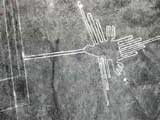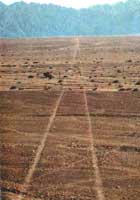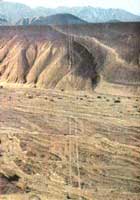|
Books by
Maria Reiche
“Markings: Aerial Views of Sacred Landscapes
by
Maria Reiche
Charles Gallenkamp
Keith Critchlow
Lucy Lippard
(Contributors)
Marilyn Bridges
(Photographer)
Haven O’More
(Preface)
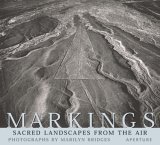
EU English Edition
“Mystery on the desert;: A study of the ancient figures and strange delineated surfaces seen from the air near Nazca, Peru”
by
Maria Reiche
Unknown Binding
1949 Edition
“Geheimnis Der Wuste/
Mystery on the desert/
Secreto De La Pampa”
German/English/Spanish
by
Maria Reiche
Hardcover
1968 Edition
“Peruanische Erdzeichen/Peruvian Ground Drawings
German & English
by
Maria Reiche
(Author)
Malcolm G. Leybourne
(Translator)
Dr. Hermann Kern
(Translator)
Hermann Kern
(Foreword)
1974 1st Edition
“Geheimnis Der Wuste/
Mystery on the desert/
Secreto De La Pampa –
Preliminaries for a Scientific Interpretation of the Pre-Histori c Ground-Drawings of Nazca, Peru and Introduction to Their Study“
German/English/Spanish
by
Maria Reiche
Hardcover
1989 7th Edition
Signed by author
Books about the Nazca
lines & geoglyphs
“Maria And The Stars Of Nazca / Maria Y Las Estrellas De Nazca”
Spanish & English
by
Anita Jepson-Gilbert
Rodger Osban
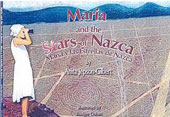
EU English Edition
“Ancient Nasca
Settlement & Society”
by
Helaine Silverman 
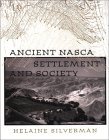
EU English Edition
“Nasca society arose on the south coast of Peru 2000 years ago and evolved over the course of the next 700 years. This text examines the range of sites occupied by the people responsible for some of the most exquisite art and ingenious hydraulic engineering of the pre-Columbian world.
|
|
The aerial photographs below show some of the human-like figures that were drawn on the Nazca Plain. There are similar ones to these found in the Islands of Prydein (Britain), where, as at Nazca, some have been etched into the sides of hills. The steep slopes on which they were drawn makes some of the geoglyphs in Prydein visible from the ground, unlike most of the landscape drawings at Nazca which are only visible from the air.

Copyright © 1997, Maria Reiche
“Another kind of figure is found on steep slopes. From the ground they are practically unrecognizable. They consist partly of light surfaces. Eyes and mouths are often marked by heaps of stones.”
Human-like figures with huge eyes – it is a mystery as to whether they are depicted wearing some form of head-dress, or if it is supposed to be sun’s rays shining out from the heads. Although like most drawings on the pampa they cover hundreds of square feet in area, they are markedly different in style from most of the geoglyphs at Nazca. Possibly they are depictions of the builders, or could represent personifications of certain heavenly bodies.
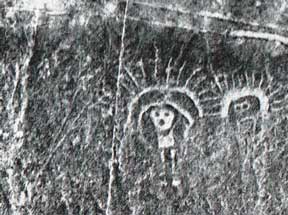
Copyright © 1997, Maria Reiche
“The figure (below) is about 98 feet high. The study of the straight lines besides it could perhaps throw light on its significance. The owl-man appears also in Peruvian pottery. Figures on slopes may be more primitive because of the steepness of the incline, or else they could belong to an earlier cultural level. The figures above could be images of the sun, the owl-man perhaps represents the moon.”
These figures are similar to ones that have been found in several parts of Britain. The huge eyes seem to be a common feature of geoglyphs wherever they are found all over the world. Other researchers into the mysteries of the past have regarded these as depictions of ‘Owl Men’, and the owl was sacred to many ancient peoples. Again, these figures can only really be appreciated from the air.
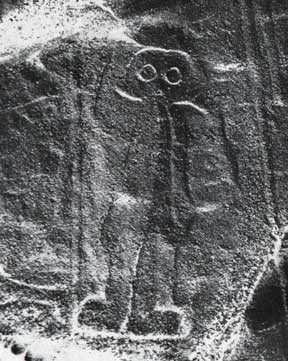
Copyright © 1997, Maria Reiche
It is said that these human-like figures represent the builders of the geoglyphs. In Britain they are referred to as ‘dodmen’, and are depicted with sighting staffs in their hands. They were regarded as the ‘landscape surveyors’ of ancient times, and would have been astronomers, or astronomer-priests, probably weilding great power and influence over their respective communities.
The unmistakable human figure below is 65 feet high, and has been drawn on the spur at the end of a plateau. A number of figures similar to this were found by Maria Reiche on several slopes, and it has been suggested by others who have visited Nazca that these figures might depict the local chieftain or astronomer-priest.
Unfortunately, most orthodox archæologists appear for some reason not to want to even comment about these magnificent ancient achievements, other than to point out that the artistic style of the various animal and human-like figures drawn on the pampa is much different to that found on the local pottery discovered during various excavations in the Nazca area.
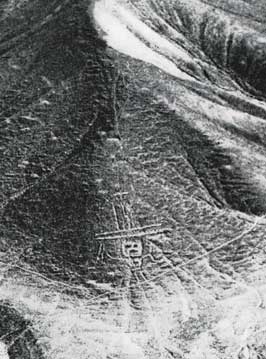
Copyright © 1997, Maria Reiche
“The figure has a hat or a burden on his head, a whip-like object in his right hand and perhaps an animal or a bird on his left arm. On the enlarged picture appears what seems to be the head of an owl. While climbing around the slopes one frequently comes across similar figures whose shapes can only be recognised from a helicopter.”
Maria Reiche was helped by many individuals and organisations during her more than 50 years of study at Nazca, and most of this was done on foot. Aerial photographs slowly became available to her courtesy of the Peruvian Government. They had originally been taken for surveying purposes, and it should be remembered that she bagan this work long before helicopters were around commercially.
“But in order to get a real picture of the great variety and the extremely complicated arrangement of lines and figures, a plane is not sufficient. A helicopter is necessary for that. When the first time one of these arrived in Peru, it was requested immediately for a flight over the pampa, which took place under the auspices of the Wenner-Gren Foundation. The pictures were taken with a large aerial camera belonging to the Servicio Aerofotografico. In order to obtain approximately vertical photographs, the author (Maria) had to take them from a board attached to the helicopter beside the cabin, the camera being held hanging down by its own weight.”
Occasional flights from Arequipa to Lima by the Health Ministry provided Maria Reiche with an opportunity to take many more photographs with a 35mm camera of some of the new drawings that continued to be discovered almost each time anyone flew over the area. Even so, most of her work was painstakingly conducted on foot.
all quotes on these tribute pages are from
“Mystery on the Desert”
by Maria Reiche
|
|
“Pathways to the Gods: The Mystery of the Andes Lines”
by
Tony Morrison
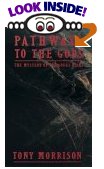
EU English Edition
“Nazca: Eighth Wonder of the World?”
by
Anthony F. Aveni
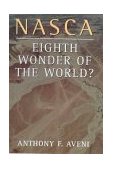
EU English Edition
“The Nasca
(Peoples of America)”
by
Helaine Silverman 
&
Donald A. Proulx 

EU English Edition
“Ancient Nasca culture of the south coast of Peru is famous for its magnificent polychrome ceramics, textiles, and other works of art, as well as the enigmatic ground markings on the desert plain at Nasca. In the past two decades much has become known about the people who produced these fascinating works. This scholarly yet accessible book provides a penetrating examination of this important civilization.”
Nazca News
more information
about the Nazca lines
& geoglyphs on
:
Landscape Geometry
Lines Over Mountains
Animals & Landscape
Figures On The Plain
The Human Scale
Birds On The Pampa
The Spider Geoglyph
& The Stars Of Orion
Spirals In The Desert
|

